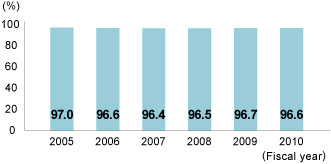Home > About Us > Sustainability Management > Sustainability Report > Sustainability Report 2011 > Reducing the Environmental Impact (air and water quality)
 Reducing the Environmental Impact (air and water quality)
Reducing the Environmental Impact (air and water quality)
| Ensuring that every aspect of our production activities is environmentally friendly and reducing environmental impact in the air and water |
"Reducing the environmental impact from production" is one of the principles outlined in the Kobe Steel Group Basic Environmental Management Policy. As such, we are committed to environmentally friendly manufacturing in every aspect of our activities, including ongoing improvements to production processes, upgrading equipment, using the latest high-efficiency facilities and installing pollution control equipment to deal with environmental pollutants. We make every effort to reduce the environmental impact that our activities place on the air, water and other elements of the environment and will continue to do so at all group companies in the future.
(Emissions data of production facilities is in the section titled "Emissions Data of Production Facilities.")
Measures to Counter Atmospheric Pollution
Air Emissions
In addition to taking steps to reduce sulfur oxide (SOx) emissions from production processes and other sources through initiatives such as saving energy to reduce fuel consumption, using low sulfur fuels and switching fuels to city gas, we continue to subject emissions to desulfurization treatment and other such measures. In terms of nitric oxide (NOx), we are focusing on reducing emissions through initiatives such as installing low NOx combustion technology and energy saving measures.
We have also installed the latest desulfurization and denitration equipment at the sintering plant at our Kakogawa Works.
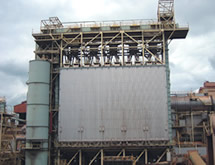
Desulfurization and denitration equipment at sintering plant
Volume of Sulfur Oxide Emissions (parent only)
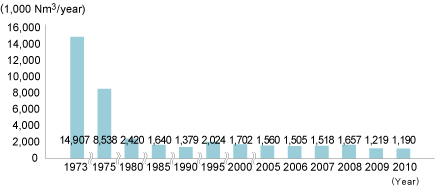
Volume of Nitric Oxide Emissions (parent only)
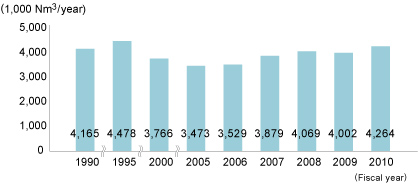
Dust Control Measures at the Kakogawa Works
We have been implementing a range of measures in an effort to reduce dust levels in the area around our Kakogawa Works ever since 2006. We set ourselves the voluntary control target of limiting steelworks-generated dust per square kilometer per month to 3.0 metric tons or less in three locations in the vicinity of our steelworks in fiscal 2008, and have been working to achieve that target ever since.
Although we achieved our target throughout fiscal 2009, we were unable to do so in May, July and August in fiscal 2010. In light of this fact, we have since stepped up activities such as cleaning and sprinkling, organized patrols, analyzed data and examined the impact of measures carried out to date.
As a result, we found that the issue in May was mainly due to localized deposits of powder in our coke plant, causing an increase in dust. We cleaned the plant and removed the deposits immediately. The fact that we exceeded our targets in July and August was mainly due to unexpected weather conditions during the summer of 2010 (frequent southerly winds), rather than any irregularities in our equipment or operations.
As we there is a strong possibility that we could fail to meet our targets again in the future in the event of similar weather conditions, we have drawn up additional plans outlining radical dust control measures in seven areas, including upgrading dust collectors, preventing waste dust from our equipment and improving our sprinkling capabilities, as well as measures at Kansai Coke and Chemicals Co., Ltd. We intend to implement these measures as effectively as possible, with assistance and guidance from the relevant authorities.
Levels of Steelworks-generated Dust (Kakogawa Shinko Building)
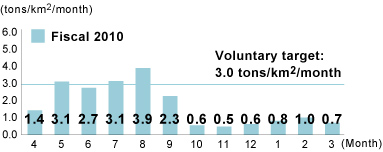
Water Pollution Prevention
In the Kobe Steel Group, the water consumption rate is being reduced by improving production processes and using recycled water. Wastewater from production processes is purified via treatment systems best suited to the properties of the relevant water so as to reduce the impact of water-polluting substances on public water supplies.
Once wastewater from individual production processes at our steelworks has been purified, using methods such as coagulation sedimentation and sand filtration, it is then reused on-site via our water recycling system. We have achieved a water recycling rate of approximately 96.6% at the Kakogawa Works and the Kobe Works.
Water Recycling Rate (Kakogawa Works)
